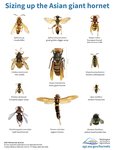

BLAINE — What was in the plastic bottles that state entomologist Chris Looney checked on Thursday, May 7, near Blaine? Something Looney hoped would lure and trap Asian giant hornet queens after they emerged from their winter homes in the ground.
The Washington State Department of Agriculture has been learning about the hornet since a Blaine-area homeowner found a dead one on his property on Dec. 8, 2019, and reported seeing a live one near a hummingbird feeder before it flew into a nearby wooded area.
They were the first sightings of the invasive honeybee-killing hornets known for their powerful, painful stings in Washington state and the U.S. About the size of an adult thumb, the Asian giant hornet, or Vespa mandarinia, is the world's largest hornet.
State agriculture officials don't know how widespread of a problem the hornets -- now widely known as "murder hornets" because of a recent New York Times article -- are in Whatcom County even as they've started to set up traps. They've asked beekeepers and the public to help as well, either by trapping or reporting suspected hornets.
The traps that Looney checked on Thursday were known as bottle traps. They were put up in a few sites in Whatcom County on April 22, according to Karla Salp of the state Department of Agriculture.
Inside the bottles are things that could tempt a queen, agriculture officials hope.
"One has the OJ/rice cooking wine mixture described on our website. One has a milk kefir mixture. The others are chemical lures that Washington State University provided us," Salp said.
Looney is seeing which of the items might be more attractive to the queens as part of a four-week experiment to try to find them. He also wanted to find out what else gets caught in the traps, Salp said.
Trapping the queens as they emerge in the spring to set up colonies is part of an effort to find and destroy the Asian giant hornets and prevent the pests from reproducing and taking hold in the Pacific Northwest.
Their native range is Asia, and they are not wanted here.
The hornets are also known as the Japanese hornet, yak-killer hornet and the giant sparrow bee. Their stingers are longer than typical, native wasps, so each sting delivers more venom.
Asian giant hornets can be nearly 2 inches long and are identifiable by their large yellow/orange heads.
Because they're new to Washington state, officials here are relying on the knowledge of their counterparts in China, Japan and Korea.
"All of the traps are experimental since no one has ever trapped in the U.S. for Asian giant hornets before," Salp said.
Asian giant hornets usually aren't aggressive toward humans unless disturbed, but people should stay at least 10 feet away from them.
In Japan, 30 to 50 people die a year after being stung by Asian giant hornets.
By comparison, a total of 1,109 people have been killed by hornet, wasp and bee stings in the U.S. from 2000 to 2017, according to the federal Centers for Disease Control and Prevention.
The number of people killed ranged from a low of 43 in 2001 to a high of 89 in 2017, according to the CDC.
The trapping that's being done now is a start. Other members of a potential colony also will be targeted.
"Later in the year, probably at the beginning of July, we'll start doing more intensive trapping for workers," Salp said to The Bellingham Herald.
The hornets feed on insects and have a voracious appetite for honeybees. Beekeepers are concerned about them because a small number of hornets can quickly destroy hives, leaving behind piles of dead bees outside.
Asian giant hornets are typically dormant during winter. They're seen usually from July through October.
They primarily nest in large colonies in the ground -- in hollows formed by rotting roots, hollow trunks and rodent burrows. They can, though rarely, nest above ground in hollow trees and human structures, state agriculture officials have said.
Report it
If you think you've seen an Asian giant hornet, the Washington State Department of Agriculture wants you to report it. Here's how:
-- Go online to the Hornet Watch Report Form.
-- Email PestProgram@agr.wa.gov.
-- Call 1-800-443-6684.
Stay updated at the Asian giant hornet watch Facebook group.
Learn more at agr.wa.gov/hornets, including how to make bottle traps for Asian giant hornets.